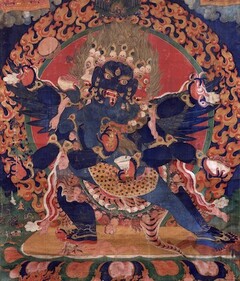Daily Kagyé Practice
༄༅། །བཀའ་བརྒྱད་རྒྱུན་ཁྱེར་བཞུགས་སོ། །
A Daily Practice of the Kagyé
by Jamyang Khyentsé Chökyi Lodrö
Taking Refuge and Generating Bodhicitta
བླ་མ་དཔལ་ཆེན་ཞི་ཁྲོའི་ལྷར། །
lama palchen zhitrö lhar
In the guru, the glorious heruka, embodiment of all peaceful and wrathful deities,
གུས་པས་སྐྱབས་མཆི་སེམས་མཆོག་བསྐྱེད། །
güpé kyab chi sem chok kyé
I devotedly take refuge, and I generate the mind of awakening.
Main Visualization
སྟོང་པའི་ངང་ལས་སྐད་ཅིག་གིས། །
tongpé ngang lé kechik gi
From the state of emptiness, instantly,
རྡོ་རྗེ་བྲག་ཆེན་པད་ཟླ་ཉི། །
dorjé drak chen pé da nyi
On the great vajra mountain upon a lotus, sun- and moon- disc seat,
བྱོལ་སོང་གཙོ་བརྒྱད་ཕྱོགས་སྐྱོང་དང་། །
jolsong tso gyé chokkyong dang
The eight animal leaders,1 the directional guardians and
ལྷ་ཆེན་རྣམས་ཀྱི་གདན་སྟེང་དུ། །
lhachen nam kyi den tengdu
The great gods,
རང་རིག་ཧཱུྃ་སྔོན་འབར་བ་ལས། །
rangrig hung ngön barwa lé
My own awareness, the blazing blue syllable hūṃ,
དཔལ་ཆེན་ཆེ་མཆོག་ཧེ་རུ་ཀཿ །
palchen chemchok heruka
Transforms into the great awesome Mahottara Heruka,
དབུས་མཐིང་གཡས་དཀར་གཡོན་དམར་ཞལ། །
ü ting yé kar yön mar zhal
His middle face is blue, right face white, and left face red.
གཡས་གསུམ་རྡོ་རྗེ་གཡོན་གསུམ་བྷན། །
yé sum dorjé yön sum bhen
His three right hands hold vajras and his three left hands hold skull-cups.
དཔལ་དང་དུར་ཁྲོད་ཆས་ཀྱིས་བརྒྱན། །
pal dang durtrö ché kyi gyen
He is adorned with the heruka and charnel-ground ornaments,
ཡུམ་ཆེན་གནམ་ཞལ་དབྱིངས་ཕྱུག་འཁྱུད། །
yumchen nam zhal ying chuk khyü
And joined in union with the great consort Dhātvīśvarī Namshalma.
དབུ་རྒྱན་ཀུན་བཟང་རིགས་ལྔ་དང་། །
ugyen kunzang rik nga dang
His head is adorned by Samantabhadras of the five families.
སྐུ་ལ་དཔལ་དགུའི་ལྷ་རྣམས་རྫོགས། །
ku la pal gü lha nam dzok
In his form the maṇḍalas of the nine herukas are perfected.
ཐུགས་ཀར་རང་འདྲའི་ཡེ་ཤེས་སེམས། །
tukkar rang dré yeshe sem
In his heart rests his own perfect likeness as the jñānasattva.
དེ་ཡི་ཐུགས་ཀར་ཀུན་ཏུ་བཟང་། །
dé yi tukkar kuntuzang
In the heart of the jñānasattva is Samantabhadra.
ཐུགས་དབུས་རྡོ་རྗེའི་ལྟེ་བ་རུ། །
tuk ü dorjé tewa ru
And in Samantabhadra’s heart is a vajra.
ཉི་ཟླའི་གའུ་ཧཱུྃ་སྔོན་པོ། །
nyidé ga'u hung ngönpo
At its centre is a locket of sun and moon containing a blue hūṃ,
གསལ་ཞིང་དྭངས་པ་རྟག་འཆར་ལས། །
sal zhing dangpa tak char lé
Lucid, limpid and unchanging.
སྔགས་ཕྲེང་འཕྲོས་ཤིང་ཞི་ཁྲོའི་ལྷའི། །
ngak treng trö shing zhi trö lhé
The mantra-mālā radiates
ཐུགས་རྒྱུད་བསྐུལ་བས་དོན་གཉིས་བྱས། །
tukgyü kulwé dön nyi jé
To invoke the wisdom minds of the peaceful and wrathful deities and accomplish twofold benefit.
སྣོད་བཅུད་དཔལ་ཆེན་དཀྱིལ་འཁོར་ཤར། །
nöchü palchen kyilkhor shar
And the environment and beings arise as the maṇḍala of the awesome heruka.
ཨོཾ་བོ་དྷི་ཅིཏྟ་མ་ཧཱ་སུ་ཁ་ཛྙཱ་ན་དྷཱ་ཏུ་ཨཱཿ
om bodhitsitta maha sukha jnana dhatu ah
oṃ bodhicitta-mahā-sukha-jñāna-dhātu āḥ ||
ཞེས་དང་།
And:
ཨོཾ་བཛྲ་ཀྲོ་དྷཱ་མ་ཧཱ་ཤྲཱིཿཧེ་རུ་ཀ་ཧཱུྃ་ཕཊཿ མ་ཧཱ་ཀྲོ་དྷཱི་ཤྭ་རཱི་སྟྭཾ། ཨོཾ་རུ་ལུ་རུ་ལུ་ཧཱུྃ་བྷྱོ་ཧཱུྃ།
om benza krodha maha shri heruka hung pé maha krodhi shori satvam om rulu rulu hung jo hung
oṃ vajra-krodha-mahā-śrī-heruka hūṃ phaṭ | mahā-krodhīśvarī sattvaṃ | oṃ ru lu ru lu hūṃ byoḥ hūṃ ||
ཞེས་དང་།
And:
ཨོཾ་བཛྲ་ཙཎྜ་སརྦ་དུཥྚན་ཏཱ་ཀ་ཧ་ན་ད་ཧཱ་པ་ཙ་ཧཱུྃ་ཕཊཿ
om benza tsenda sarwa dushten taka hana dahapatsa hung pé
oṃ vajra-caṇḍa-sarva-ḍuṣtāntaka hana daha paca hūṃ phaṭ ||
ཅེས་པ་རྣམས་བཟླས་མཐར།
At the end of the mantra recitation, recite:
སྣང་ཆའི་ལྷ་སྐུ་འོད་གསལ་ངང་། །
nangché lha ku ösal ngang
Within luminosity the perception of the deity dissolves.
སླར་ཡང་གཉུག་མའི་ཕྱག་རྒྱར་ལྡང་། །
lar yang nyukmé chakgyar dang
Then again, I arise in the deity’s genuine form.
ཨོཾ་ཨཱཿཧཱུྃ༔
om ah hung
oṃ āḥ hūṃ
ཞེས་བྱིན་བརླབ་དགེ་བསྔོ་ཤིས་བརྗོད་རྣམས་བྱའོ། །
Thus bless the practice. Then dedicate, make aspirations, and recite prayers of auspiciousness.
ཞེས་པའང་ལྭ་དཀར་བུ་བསོད་ནམས་རྒྱལ་མཚན་གྱི་བཞེད་ངོར། ཆོས་ཀྱི་བློ་གྲོས་པས་སོ།། །།
This was composed by Chökyi Lodrö at the request of Sönam Gyaltsen, son of the Lakar family.
| Samye Translations, 2019 (trans. Stefan Mang).
Source:
'jam dbyangs chos kyi blo gros. "bka' brgyad rgyun khyer" in gsung 'bum/_'jam dbyangs chos kyi blo gros/ (dbu med/). TBRC W21813. 8 vols. gangtok: dzongsar khyentse labrang, 1981-1985. http://tbrc.org/link?RID=W21813 Vol. 3: 225–226
- ↑ The eight animal leaders (byol song gtso brgyad) are: 1) tiger, 2) lion, 3) leopard, 4) bear, 5) elephant, 6) water buffalo, 7) crocodile, and 8) cobra.
